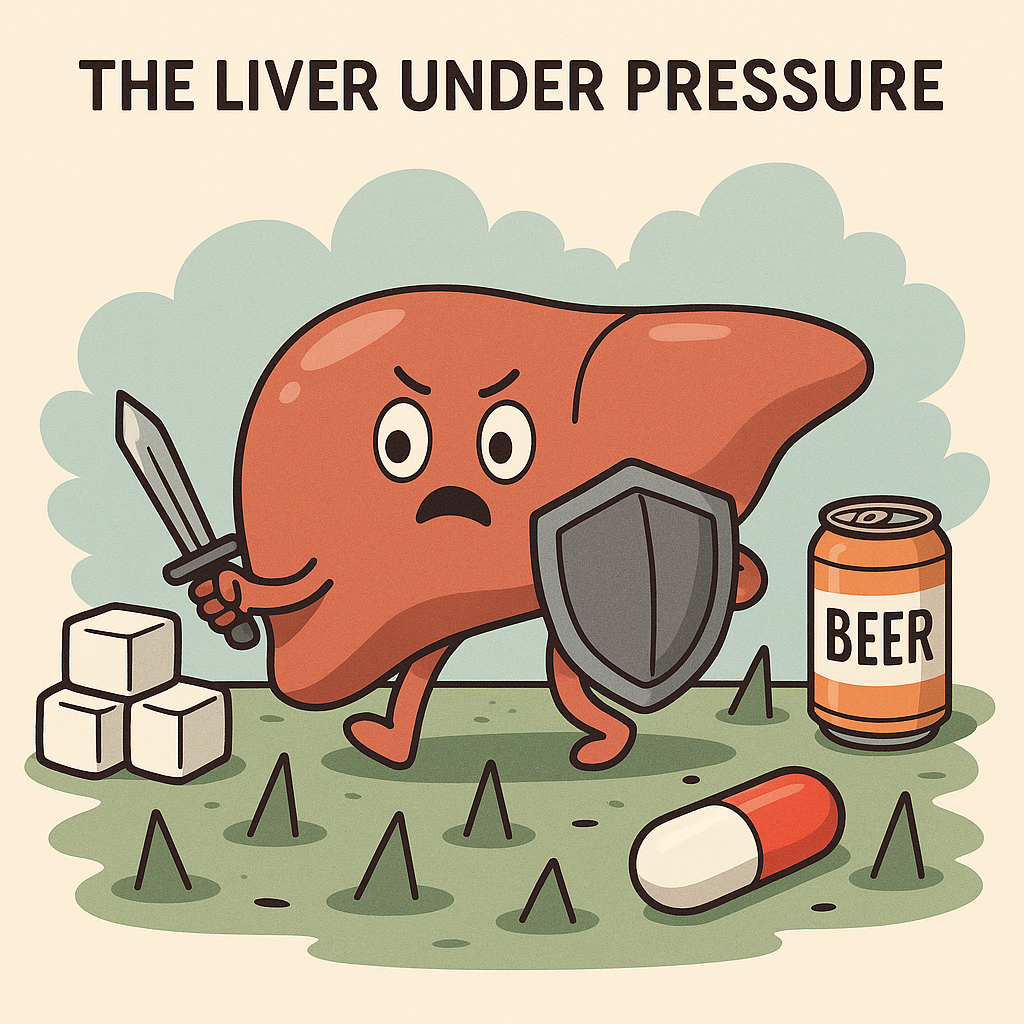🧬 The Liver Under Pressure: Understanding Liver Disease and Its Many Faces

Health & Sciences | The Varrock Street Journal
Good morning to all of our wonderful readers!
We don’t often think about the liver until something goes wrong. Quietly tucked beneath the ribs, this powerhouse organ is responsible for hundreds of life-sustaining tasks—from filtering toxins and metabolizing medications to helping us digest fats and store vitamins.
But when the liver starts to fail, the consequences ripple across the entire body. Today, we’re unpacking the different causes of liver disease, the science behind it, and why alcoholic liver disease continues to be one of the most preventable—yet deadly—forms in North America.
🏥 What Is Liver Disease?
“Liver disease” refers to any condition that damages the liver and prevents it from functioning properly. Over time, damage may cause inflammation, scarring (fibrosis), and ultimately cirrhosis—a condition where healthy liver tissue is replaced by scar tissue, reducing liver function.
If left untreated, liver disease can progress to liver failure or liver cancer.

🧪 Major Causes of Liver Disease
There are many different causes and types of liver disease, including:
🔹 Non-Alcoholic Fatty Liver Disease (NAFLD)
- Most common in the U.S.
- Linked to obesity, insulin resistance, and metabolic syndrome
- Fat builds up in the liver even without alcohol use
🔹 Viral Hepatitis (Types A, B, C)
- Hepatitis A: Acute, from contaminated food/water
- Hepatitis B & C: Can become chronic and lead to cirrhosis or liver cancer
- Spread through blood or body fluids
🔹 Autoimmune Hepatitis
- The immune system mistakenly attacks liver cells
🔹 Genetic Conditions
- Hemochromatosis (iron overload)
- Wilson's disease (copper buildup)
🔹 Drug- and Toxin-Induced Liver Injury
- From overuse of medications like acetaminophen, certain antibiotics, or herbal supplements

🍷 Deep Dive: Alcoholic Liver Disease (ALD)
Alcoholic Liver Disease is one of the most well-known—and misunderstood—forms of liver damage. It results from chronic and excessive alcohol consumption over time, and it progresses in stages:
1. Fatty Liver (Steatosis)
- Reversible if alcohol is stopped
- Often asymptomatic
2. Alcoholic Hepatitis
- Inflammation of the liver
- Can be life-threatening if severe
3. Cirrhosis
- Irreversible scarring of the liver
- Can lead to liver failure, cancer, and death
Who is at risk?
- Long-term alcohol use (typically 8+ drinks/week for women, 15+ for men)
- Genetics, poor nutrition, coexisting viral hepatitis
Why it matters: ALD is responsible for thousands of preventable deaths each year, and many people may not know they’re at risk until it’s too late. Early detection and stopping alcohol intake can halt or even reverse the early stages of disease.
🩺 How Is Liver Disease Diagnosed?
Doctors rely on a mix of clinical symptoms, lab tests, and imaging:
- Blood tests (liver enzymes like ALT/AST, bilirubin, INR)
- Ultrasound or CT scan to detect inflammation or fat
- FibroScan or liver biopsy for scarring and staging
- Physical signs like jaundice (yellowing of skin/eyes), abdominal swelling, or easy bruising

💊 Treatment Options
The treatment depends on the cause:
- Alcoholic liver disease: Complete abstinence from alcohol, nutritional support, sometimes steroids
- NAFLD: Weight loss, blood sugar control, healthy diet
- Hepatitis B or C: Antiviral medications
- Autoimmune hepatitis: Immune-suppressing medications like steroids or azathioprine
- Cirrhosis: Managing complications, possible liver transplant
Here is a podcast discussing liver disease if you want!
🧠 Why This Matters
Liver disease often develops silently—with few symptoms until significant damage has occurred. Raising awareness about risk factors and early testing could prevent thousands of deaths each year.
Most importantly, many forms of liver disease are preventable. With changes in diet, alcohol use, and lifestyle, people can protect this vital organ.
🌟 Spotlight on the Future
- Non-invasive diagnostic tools like blood-based fibrosis panels and improved imaging are reducing the need for biopsies.
- New drugs for NASH (non-alcoholic steatohepatitis) are in late-stage trials.
- Public health programs are focusing on alcohol use screening and hepatitis C elimination efforts.
😲 Did You Know?
- The liver is the only organ that can regenerate itself—but only up to a point.
- Over 100 million Americans have some form of fatty liver disease.
- ALD is responsible for nearly half of all cirrhosis-related deaths in the U.S.
🧠 Reflection Questions
- Have you or someone you know been screened for liver disease risk factors?
- What small lifestyle changes could support your liver health today?
- How can healthcare systems do better at identifying early signs of liver dysfunction?
👋 Final Thoughts
Your liver works hard—often silently—for you. Understanding how it can be damaged, and what we can do to protect it, is a vital step in taking care of the body as a whole. Whether it’s alcohol, sugar, or viruses, early awareness is the best medicine.
📚 References
- American Liver Foundation. (2024). Liver Disease Overview. https://www.liverfoundation.org
- Mayo Clinic. (2024). Alcoholic Hepatitis and Cirrhosis. https://www.mayoclinic.org
- CDC. (2024). Fatty Liver Disease Statistics and Public Health Guidance. https://www.cdc.gov
- Cleveland Clinic. (2024). Understanding Liver Function Tests. https://my.clevelandclinic.org
📲 Stay tuned for more inside medicine:
- Instagram: @thevarrockstreetjournal
- TikTok: @varrock.street.jo
